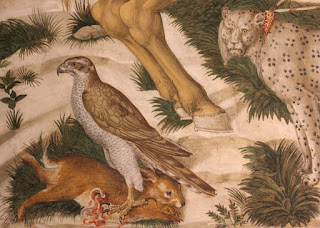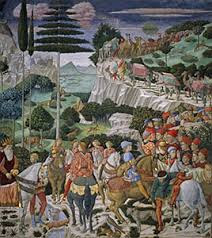As we have described in another blog entry, Benozzo Gozzoli paints the Journey of the Magi
on the walls of the private family chapel in the Medici Palace in Florence in 1459-60. On the
walls are horsemen, the three Magi or Kings, portraits of friends of the family as well as family members, and something not mentioned in the first blog, ANIMALS, many, many animals, and birds.
Two scenes show shepherds with their sheep, oxen, dogs, and donkey, all appropriate for the scene
describing the Nativity of Christ in Luke:

On the wall of the Youngest King, a deer is being chased in a hunt:
while above that scene a rabbit peeks out of a protected warren and hopes the nearby dog doesnot smell him (yellow arrows mine):
Far from being a static landscape painted behind the scene of the procession, nature "red in tooth and claw" is on display, with a hawk flying after a pheasant in the sky above the middle-aged king,
a leopard attacking a bull near the oldest king,
another leopard running for a deer beyond those,

and a rabbit caught by a hawk and spilling its entrails close to the viewer at the bottom of the scene:
leopard (paw-mark spots) being held by two ropes by the falconer in the same scene:
or the cheetah, (single spots) on the horse with the page dressed in light blue:

or the monkey perching on a horse like a person at the edge to catch the viewer off-guard:

The ducks and the Bactrian camels (two humps) and dromedaries (one hump) all are placid in their
places, but they are foils to the violence occurring around them:

The artist has carried out his job of portraying the Medici family and allies intermingled in the
procession of an ancient story of important figures on their way to pay respects to a single child
who has just been born. But Gozzoli is absorbing more than what he has observed in the landscape
of Tuscany around him over the seasons; he is doing two things here:
1) he is recording some of the wild animals that the Medici owned as part of their private zoo,
exotic animals from far away, in competition with Marco Polo and his observations of the
wild animals of the East (see blog entry on Gozzoli and Marco Polo.) The cheetah, leopard, camel, monkey are all non-native species that speak of the enormous wealth of the Medici in their ability to procure animals from far-off lands.We know that when Lorenzo il Magnifico is older (1486), he is given a giraffe by the Sultan of Egypt to add to his collection of wild animals. The giraffe does not figure in Gozzoli's frescoes precisely because it was not part of the Medici zoo during this period, but the other animals could have been observed first-hand by Gozzoli. Most of the most exotic are depicted on one wall, that of the Oldest king, and it is as though Gozzoli wished to corral these creatures into a space together to form a zoo on the wall. In painting these creatures in the private chapel, he has documented for history the animals that formed part of the Medici zoo in the 15th century.
2)he is recording the violence of nature behind the human figures also as part of his own observations
of human nature and its potential for violence as well. Some of the human faces are far from happy
and the allies the Medici count as friends are perhaps less adoring and loyal than they think:
Sigismondo Malatesta, for instance, looks daggers at his hosts, as though not wanting to be part of
their political parade:
In the group of men behind the second portrait of Gozzoli on the oldest king's wall, the "zoo" wall,
some of the Florentine "friends" seem to gather together to conspire; they seem to whisper to each other as they look across the wall at the members of the Medici family.
We know that eighteen years after the frescoes were painted, a conspiracy was gathered just this way. In 1478 the Pazzi "friends" decided to try to assassinate Lorenzo the Magnificent and his brother; they only succeeded in killing Giuliano in the Duomo during Easter Sunday mass, Lorenzo escaped, but the violence which then ensued in the chase after the conspirators led all the way to Constantinople, where the last of them was caught and brought back. Most were hung and quartered in vicious ways, bodies dragged through the streets of Florence and put on display on the walls of the Bargello. So the undercurrent of violence in human society is hinted at by Gozzoli in his portrayal of nature as competition for survival.



















No comments:
Post a Comment